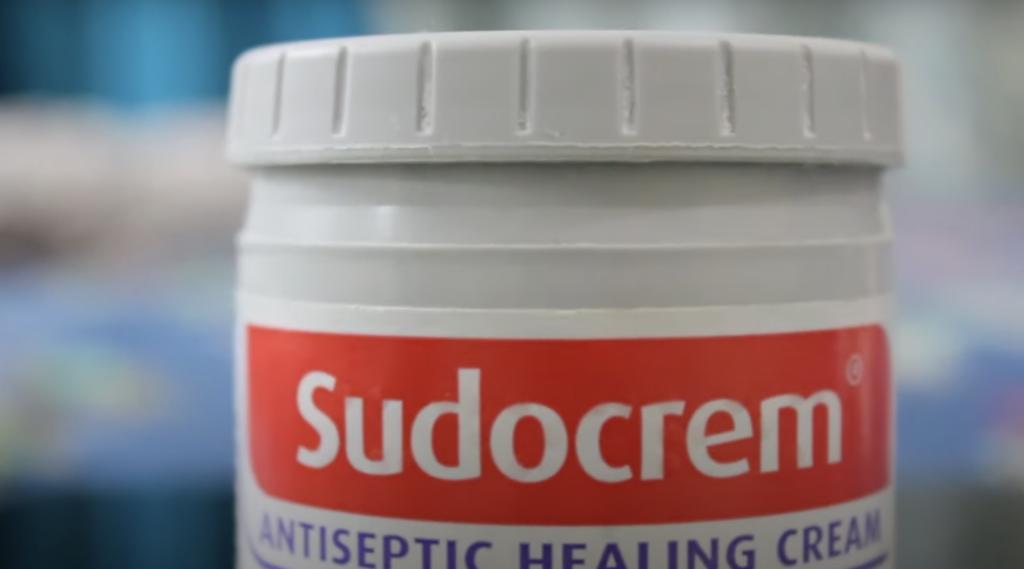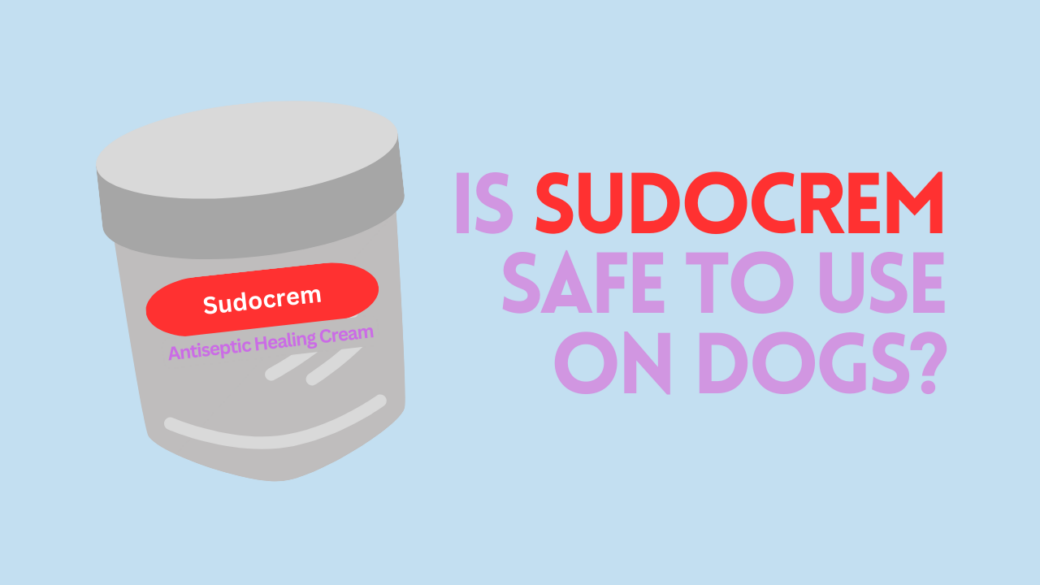When a dog begins scratching its skin, it can be difficult to get them to stop. Phoning the vet and getting professional advice should be the first action a dog owner does, but this isn’t always possible. If the vet is shut or appointments aren’t available at the time, finding a suitable, one-off treatment, like an antiseptic cream, can help ease itchiness and discomfort.
Not all dog owners will have an antiseptic cream specifically made for dogs to hand, though. Some human products can be used. Remember, most human medications should not be used on dogs, but there are a few that are considered safe to use on dogs; is Sudocrem one of them?
Applying Sudocrem to your dog is safe to do when applied correctly. It is a medicated cream specifically made for humans, so it can cause dogs to suffer from side effects, especially if the cream is ingested. To find out more about these adverse reactions, and how to avoid them, continue reading this article.
Table of Contents
What is Sudocrem?
Many people in the UK, especially parents, are familiar with Sudocrem Antiseptic Healing Cream, so much so that it has been dubbed a “parent’s simple, effective ally”. This product, which was initially formulated in 1931 to relieve nappy rash, has antibacterial and antifungal properties, and it has since become a popular ointment for acne, eczema, and other types of sore skin.
As an over-the-counter cream, Sudocrem is available to buy in pharmacies and supermarkets. As it is safe to use on the skin of all ages and is easy to access, most families will have this product, or a similar alternative, in their medicine cupboards.

Just because it is safe to use on both adults and children doesn’t mean it is safe to use on dogs; some of the ingredients in this ointment can be dangerous for dogs, especially if they ingest it.
Ingredients in Sudocrem
The ingredients in Sudocrem have remained the same since it was first manufactured due to their success in soothing and healing all varieties of skin irritation.
Anhydrous Hypoallergenic Lanolin
This ingredient works by forming an oily layer to retain moisture to soothe and soften irritated skin. It can help to reduce flaky and itchy skin conditions that are caused by irritation.
Anhydrous hypoallergenic lanolin is considered safe to use on dogs.
Benzyl Alcohol
Essential to reduce discomfort, Benzyl alcohol has local anaesthetic and antiseptic properties. It will disinfect any cuts and scrapes, preventing bacterial infections while relieving dogs of aches and pain.
Benzyl alcohol has low toxicity and vapour pressure measurement, so it is a relatively safe ingredient to be used on dogs. Plus, it is found naturally in plants and fruits; however, it should not be consumed in high quantities.
Zinc Oxide
Zinc oxide is an essential ingredient that helps to reduce the loss of hydration from the skin. It forms a barrier on the skin to protect from irritations, which blocks out bacteria and locks in moisture.
It is safe to use on skin, but if ingested, zinc oxide can be incredibly toxic to dogs. This is why, if you apply this cream to your dog’s skin, ensure the dog cannot lick the cream, and it is applied in a thin layer.
Can You Put Sudocrem on Dogs?
Sudocrem can be put on dogs when used appropriately, although it should not be a regular treatment choice. It can be used to deal with cuts, scrapes, and minor skin irritations.
However, it should only be used in small quantities as it is not formulated to be used on dogs’ skin; a dog’s skin has a different pH than a human’s, and it will be sensitive to products that human skin is not. Although you can put Sudocrem on dogs, it can sometimes cause skin irritation and other side effects, especially if the dog is allergic to specific components of the antiseptic cream.
Another reason to be wary of using Sudocrem on dogs is the possibility that the dog may ingest the product. Some of the ingredients in Sudocrem, specifically zinc oxide, can poison dogs. This is known as zinc poisoning or zinc toxicosis. It is essential the antiseptic cream is placed where a dog cannot lick, or the area is covered after the cream has been applied.
Human medications that are safe for dogs should only be administered if a vet advises it. A vet will advise on how to use Sudocrem on your dog’s skin or prescribe a product specifically for dogs.
Can You Put Sudocrem on a Dog’s Ears, Eyes, Mouth, or Nose?
No, Sudocrem should not be used on a dog’s ears, eyes, mouth, or nose; these areas are very sensitive to medicated creams. It can be used on the skin of the outer ears, but the inner ears should be avoided.
Can Sudocrem Be Used on a Dog’s Cut?
Yes, Sudocrem can be used on a dog’s cut if the wound does not require veterinary attention. However, it must be used in a manner that is safe for dogs; the wound should be cleaned, the coverage of Sudocrem should be light, and the dog must be supervised.
In What Situations Can You Use Sudocrem on Dogs?
Sudocrem should only be used on dogs every once and a while; it should not be a regular treatment option. If your dog requires regular use of antiseptic cream, a vet should be contacted to prescribe a dog-specific product.
Sudocrem can be used on dogs to ease:
- Bum itching
- Flea bites
- Severe scratching
- Small cuts
As it protects the skin, Sudocrem can also be used on dogs during the summer months to shield exposed skin from the sun.
How to Put Sudocrem on a Dog Safely
When using Sudocrem on your dog’s skin, the first step is to clean the area. You do not want to trap any bacteria under the cream; instead, you should clean the skin or wound to reduce the risk of infection. Warm water mixed with either mild soap, salt, or a product like Hibiscrub will wash away bacteria or dirt.
The dog’s skin should then be dried with a clean towel before applying the cream. Only a small amount of Sudocrem should be applied to the dog’s skin. The skin needs to breathe, and too much Sudocrem can cause the area to become clogged and reduce successful healing. Using too much of this antiseptic healing cream can also become messy and increase the dog’s risk of licking it off.
When you apply Sudocrem on dogs, follow the instructions on the cream’s packaging or those provided by the vet. It should be rubbed into the skin lightly.
You can then cover the affected area of the dog’s skin with a bandage or dressing to stop the dog from licking the cream. An Elizabethan can also be used to stop the dog from licking Sudocrem.

What If a Dog Licks Sudocrem?
Although Sudocrem is safe for dogs and humans, this only applies to skin applications. If the cream is ingested, there could be adverse effects. This is primarily due to one component in the antiseptic healing cream, as previously mentioned: zinc oxide.
7 Signs of Zinc Poisoning
If a dog consumes too much zinc
- Anaemia – When there is a lack of healthy red blood cells carrying oxygen, this is called anaemia. This can lead to lethargy and weakness, which are also signs of zinc poisoning.
- Cyanosis – This is a sign of severe zinc poisoning. A lack of oxygen in the bloodstream causes the lips, nails, and skin to become discoloured, taking on a bluish tinge.
- Diarrhoea – Zinc toxicosis can affect your dog’s stools, and diarrhoea can cause dehydration.
- Lethargy – If your dog suddenly isn’t as alert as it usually is and appears more tired, this could be a sign of zinc oxide toxicosis.
- Vomiting – Similar to diarrhoea, vomiting can cause the dog’s bodily fluids to become imbalanced, leading to dehydration and other health issues.
- Weakness – Like lethargy, weakness can present itself as a result of zinc poisoning. A dog will lack energy, which is usually easy to determine if you own a lively dog breed.
- Weight loss – If your dog is suddenly losing weight without an apparent reason, it could be due to zinc oxide, which can disrupt its metabolism.
How Does a Vet Treat Zinc Poisoning?
If a dog suffers from a mild case of zinc poisoning caused by Sudocrem, a vet might induce vomiting to empty the dog’s stomach. Activated charcoal may also be used to stop more zinc from being absorbed into the dog’s body.
In extreme cases of zinc toxicosis, the dog might require supportive care, such as IV fluids and other medications, and it will be kept in the veterinary practice for observations.
Thankfully, zinc toxicosis has a relatively positive prognosis if caught and treated effectively.
To Sum Up
Although Sudocrem for dogs should not be a regular treatment, it can be used to ease discomfort in certain situations. It can be used safely to treat flea bites, itching and scratching, and minor cuts and scrapes. If it is used, it should only be put on dogs in small amounts and in areas where the cream cannot be licked. Sudocrem should never be used near the ears, eyes, mouth, and nose.
It can be used to soothe a dog’s irritated skin or discomfort caused by cuts and scrapes if the dog cannot lick the affected area. Ingesting large quantities of Sudocrem could result in zinc oxide poisoning, which can cause anaemia, lethargy, weight loss, and other health problems. Due to these potential health issues, dog owners should use caution when they apply Sudocrem to their dogs.
If you want to put Sudocrem on your dog, remember it is only safe to do so if you use it as instructed.
Disclaimer: This article is for informational purposes only and should not be used as a substitute for professional veterinary advice.

